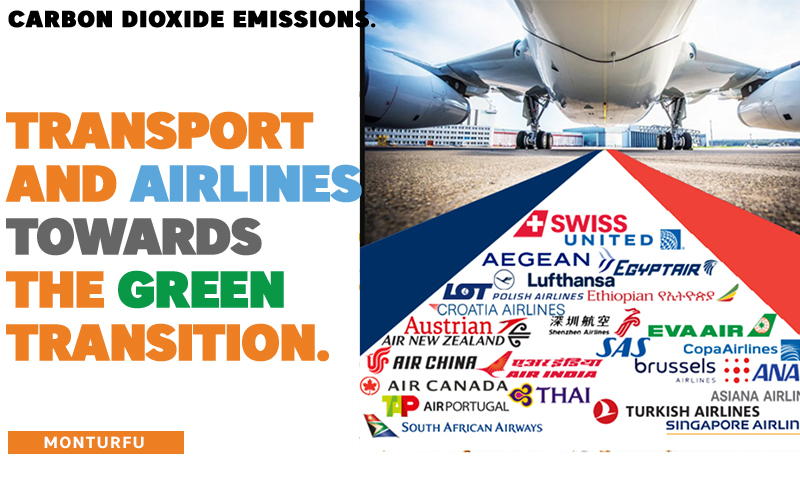CARBON DIOXIDE EMISSIONS.
TRANSPORT AND
AIRLINES TOWARDS
THE GREEN TRANSITION.
Air travel is changing. Especially with the emergence of flight comparators, travelers are asserting themselves as players in the sector. From now on, the criterion of carbon dioxide emissions from flights is included in certain flight comparison sites, such as EasyVoyages and Skyscanner. In a highly competitive environment, the climate criterion will have an increasing impact on commercial performance. And the regulators, essentially European for the moment, are determining the direction of the airlines.
Europeans love air travel.
According to Eurostat figures, 1.1 billion travelers opt for air travel in the European Union in 2018, an increase of 6%, so +63 million over one year.
Since 2015, the number of passengers has grown by 20%, or +187 million. And from 2016 to 2018 the highest growth rates in 10 years are recorded. Ultimately, flights between two EU countries represent 46% of trips and domestic flights 16%. As a result, Europeans’ appetite for air travel is growing by 5% per year.
Carbon dioxide emissions as impact assessment criteria.
For comparison purposes, to assess the impacts of different modes of transportation, we consider the carbon dioxide emissions for a passenger traveling one kilometer by that mode.
Thus, one hour in a plane is 13 times more emitting than one hour in a car. And getting on a plane is 1500 times more emitting than getting on a train.
What is IATA ?
The International Air Transport Association, IATA, a lobby with 290 member airlines, says it wants to achieve zero carbon by 2050 through sustainable fuels, electrical advances and the development of carbon sinks.
Carbon dioxide emissions and the IATA challenge.
Zero net carbon emissions in 2050 while the sector of the general manager Zero net carbon emissions in 2050 while the sector of the general manager Willie Walsh represents in 2021, 3% of global greenhouse gas emissions. That is 0.9 billion tons of carbon dioxide per year.
Today 7 billion and certainly 10 billion in 2050. The airlines are taking up the challenge of transporting so many passengers without contributing to global warming.
IATA, the International Air Transport Association, announced the color from the outset at its 77th General Assembly on October 3, 4 and 5, 2021 in Boston in the United States of America. It plans to green civil aviation.
Increase flight volume and reduce carbon dioxide emissions.
For us, the main objective is to continue to grow, because it’s not passenger traffic that’s the enemy, it’s emissions, says IATA Vice President for Environment and Sustainability Sebastian Mikosz.
Indeed, the airline industry carries 4.5 billion passengers in 2019. And aware of the resources and opportunities, IATA forecasts 10 billion civilian flights per year by 2050.
Air traffic in the European Union.
IATA, by setting a net zero emissions objective, is de facto joining the roadmap of European airlines, airports and industry. This direction also corresponds to the COP26 guidelines. For its part, IATA estimates the budget needed to gradually reach zero net emissions by 2050 at 1,550 billion.
At the same time, the European Union intends to reduce its carbon dioxide emissions by 55% by 2030 compared to 1990. And the United States wants to reduce emissions from commercial aviation by 20% by 2030, relative to the current trajectory.
From the idea to the implementation of the action plan.
Once we go beyond the idea of climate danger because we are beyond greenhouse gas emissions, we rightly set the conditions for its decarbonization.
All over the world, popular movements are becoming more and more tense and are putting pressure on the various economic actors and government authorities. As for example the Flygskam, shame to fly which officiates since 2018 in Sweden. To this end, between 2009 and 2019, airlines improve their energy efficiency by 21.4%. Nevertheless these factual efforts still do not prevent the sector’s emissions from growing.
Carbon dioxide emissions and the emergence of biofuels.
The aviation industry expects to achieve 65% of its goals through the use of sustainable fuels. The corresponding anglicism is Sustainable Aviation Fuels, SAF. It is a mixture of biomass, waste oil, carbon dioxide etc.. These fuels have the advantage of being directly compatible with modern aviation.
In addition, they are certified to accept blends of up to 50% in fossil fuel. And at the same time they reduce carbon dioxide emissions by 80% compared to kerosene over their entire life cycle.
Implementation of biofuels.
In concrete terms, Airbus and Boeing are working to make their aircraft fly with 100% SAF by 2030. However, the slight downside is that today SAF accounts for less than 0.1% of the fuel used to power aircraft. In technical terms, to reach the IATA objectives, the production of sustainable fuels must be increased by 10,000%.
SIA.
Singapore Airlines Group, SIA is committed to achieving net zero carbon emissions by 2050. SIA is actively working with partners and stakeholders to explore opportunities to increase the adoption of sustainable aviation fuels across the alliance.
Carbon dioxide emissions.
Star Alliance company CEO Goh Choon Phong says in a statement : We have remained focused on our sustainability goals even as we navigate the Covid-19 pandemic. We know this is also an increasingly important issue for our customers and staff. With today’s pledge to achieve net zero emissions, we are reinforcing the SIA Group’s leadership position on this issue and strengthening our commitment to finding ways to combat our impact on the environment.
Qu’est-ce que le réseau Star Alliance ?
The alliance’s member carriers include the largest airlines and smaller regional aviation companies. Together, they offer one-way connections to virtually every destination in the world.
Each airline retains its own cultural identity and know-how. These distinctive features reflect the rich diversity and multiculturalism of the alliance. These airlines respect and observe the highest standards of safety and customer service.
Factors for reducing carbon dioxide emissions.
Always has Goh Choon Phong to add : Today, the most effective and direct way for an airline to significantly reduce its carbon emissions is to operate a young fleet of aircraft. The SIA Group fleet has an average age of less than six years, making it one of the youngest in the world. Over the past year, we have retired 45 older aircraft from our fleet. We will gradually replace them with new generation aircraft that are up to 30 percent more fuel efficient, and we will significantly reduce our emissions in the years to come.
Some necessary support in the green transition of civil aviation.
This time to Goh Choon Phong to conclude : However, we cannot achieve our goals alone. We will continue to collaborate with governments, the airline industry and partners such as manufacturers, technology providers and fuel suppliers, both in Singapore and globally. We must work together to push the boundaries and find innovative solutions that help us achieve our goals along this journey.
Quelques appuis nécessaires dans la transition verte de l’aviation civile.
Cette fois ci à Goh Choon Phong de conclure : Cependant, nous ne pouvons pas atteindre nos objectifs seuls. Nous continuerons de collaborer avec les gouvernements, l’industrie du transport aérien et des partenaires tels que les constructeurs, les fournisseurs de technologie et les fournisseurs de carburant, à la fois à Singapour et dans le monde. Nous devons travailler ensemble pour repousser les limites et trouver des solutions innovantes qui nous aident à atteindre nos objectifs tout au long de ce voyage.
A whole new industry to build.
On the other hand, biofuels and synthetic fuels, or e-fuels, appear to be the royal road to achieving zero net carbon emissions. Therefore, a whole new sector must emerge in order to increase volumes and lower prices. The EU wants to encourage this with a progressive tax on kerosene for flights within the EU, and the United States is already offering a tax credit.
Ok de-MEDEIROS
SOURCES : https://start.lesechos.fr/societe/environnement/comment-laerien-compte-ne-plus-polluer-dici-2050-1352354, https://www.sciencesetavenir.fr/nature-environnement/voler-plus-sans-polluer-l-equation-a-multiples-inconnues-du-transport-aerien_158360, https://www.geo.fr/environnement/voler-plus-sans-polluer-lequation-a-multiples-inconnues-du-transport-aerien-206765#:~:text=%22On%20a%20estim%C3%A9%20que%20d,rassemblant%20une%20cinquantaine%20d’ONG, https://www.latribune.fr/entreprises-finance/services/transport-logistique/zero-emission-dans-l-aerien-en-2050-l-iata-mise-sur-les-carburants-verts-plutot-que-sur-l-hydrogene-893682.html , https://www.marianne.net/societe/ecologie/laerien-zero-carbone-des-2050-cest-tout-bonnement-impossible, https://theshiftproject.org/wp-content/uploads/2021/03/Pouvoir-voler-en-2050_ShiftProject_Rapport-2021.pdf, https://www.liberation.fr/environnement/objectif-zero-emission-nette-dici-a-2050-les-belles-promesses-du-secteur-aerien-20211006_KE6K47WYANCHHACUJCTO3WIYY4/, https://www.resistanceclimatique.org/veille-aviation , https://www.francetvinfo.fr/replay-radio/chronique-du-ciel/greenfly-la-compagnie-verte_4861579.html , https://www.lemondedelenergie.com/aviation-climat/2021/12/22/






Laisser un commentaire